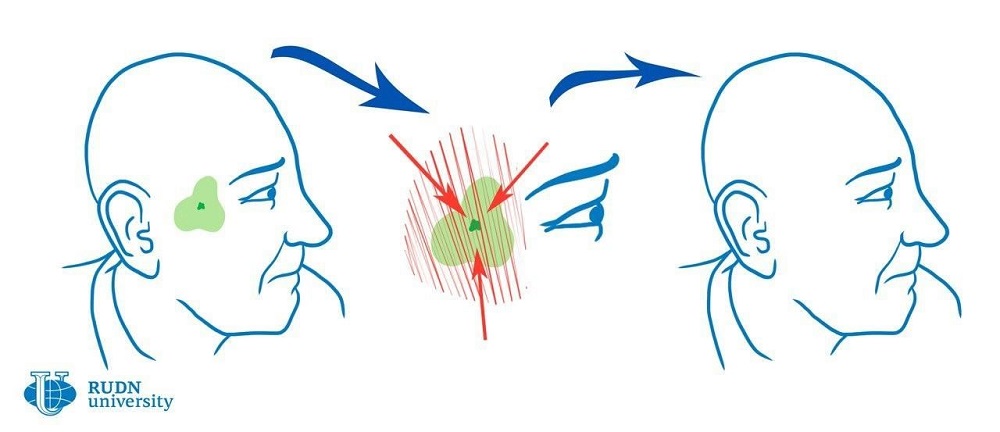Oncologists of RUDN offered safe means for treatment of a bazalno-cellular cancer of skin

More than 2.5 million cases of basal cell carcinoma are registered annually in the world. At the same time, traditional approaches to the treatment of this disease, such as surgical or radiation therapy may be unsuitable if concomitant diseases weaken the patient. In addition, if the neoplasm is located on visible parts of the body, the use of these approaches is undesirable from a cosmetic point of view. Photodynamic therapy with the help of the Russian medicine “Levulon” allowed patients to get rid of oncology without leaving noticeable skin damage.
“Aminolevulinic acid is widely used for fluorescence diagnostics and photodynamic therapy. Photodynamic therapy with 5-aminolevulinic acid is a common approach to the treatment of malignant tumors, including basal cell carcinoma. The purpose of this study was to study the safety and effectiveness of photodynamic therapy mediated by 5-aminolevulinic acid of the drug ‘Levulon’ among patients with basal cell carcinoma,” — Andrey Kaprin, Doctor of Medical Sciences, Head of the Department of Urology and Operative Nephrology of RUDN Medical Institute
5-aminolevulinic acid is a metabolic precursor of porphyrins, compounds from which heme are subsequently formed, participating in the transport of oxygen in the hemoglobin of the blood. In addition, porphyrins belong to the class of photosensitizers — substances that can change the sensitivity of tissue to light. When 5-aminolevulinic acid is applied to the affected area, it selectively accumulates in tumor cells and is metabolized into porphyrins, which, under the influence of laser radiation, cause the accumulation of reactive oxygen species that destroy tumor cells.
During the study, the Russian medicine “Levulon” was tested on a sample of 15 men and 67 women. 119 tumors on the head, neck, trunk and limbs of patients were treated. Physicians confirmed the diagnosis by cytological methods and ultrasound analysis. Before using the drug, the keratinized layer was scraped off each tumor, after which a gel was applied and the entire area was covered with an opaque moisture-resistant material. After three hours of incubation, RUDN oncologists conducted a photodynamic therapy session using laser radiation with a wavelength of 630 nm with a repeat therapy session after four weeks and a subsequent assessment of the tumor condition. Patient survival was analyzed using Kaplan-Meyer curves after one year and three years.
Photodynamic therapy was performed after the administration of anti-inflammatory drugs, while all patients experienced minor or moderate pain. Three months later, in 96% of cases, tumor necrosis was observed with a brilliant cosmetic effect — the absence of scars and tissue defects. At the same time, five patients with a partial response to treatment underwent another session of photodynamic therapy with intravenous administration of another photosensitizer. New foci of basal cell carcinoma after treatment were diagnosed in only three patients. They underwent repeated photodynamic therapy using “Levulon” gel.
The analysis of survival in the group of patients with a complete response to treatment showed that one year after therapy, the survival rate was 92.1%, and three years later — 88.3%. When comparing the results of photodynamic therapy with “Levulon” in patients with primary and recurrent tumors, the survival rates were as follows: one year — 96.4% vs. 77.8%, three years — 91.6% vs. 77.8%.
“According to the results of the study, photodynamic therapy using Levulon in patients with superficial basal cell skin cancer is effective and safe,” — concludes Andrey Kaprin.
The results of the study were published in Photodiagnosis and Photodynamic Therapy.
The project to develop a cellular model of the placenta became the winner in the Scientific Materials category of the Young Scientists 3.0 competition, organized with the support of the Presidential Grants Foundation and T-Bank.
Ten scientific journals published by RUDN University have been included in the highest level of the state list of scientific publications, the White List.
Forests are not only the lungs of the planet, but also home to millions of species. However, it has remained unclear how underground interactions between trees and fungi affect forest species richness in different climatic conditions. Previous studies have yielded conflicting results: in some regions, the dominance of certain fungi reduced tree diversity, while in others it increased it.
The project to develop a cellular model of the placenta became the winner in the Scientific Materials category of the Young Scientists 3.0 competition, organized with the support of the Presidential Grants Foundation and T-Bank.
Ten scientific journals published by RUDN University have been included in the highest level of the state list of scientific publications, the White List.
Forests are not only the lungs of the planet, but also home to millions of species. However, it has remained unclear how underground interactions between trees and fungi affect forest species richness in different climatic conditions. Previous studies have yielded conflicting results: in some regions, the dominance of certain fungi reduced tree diversity, while in others it increased it.